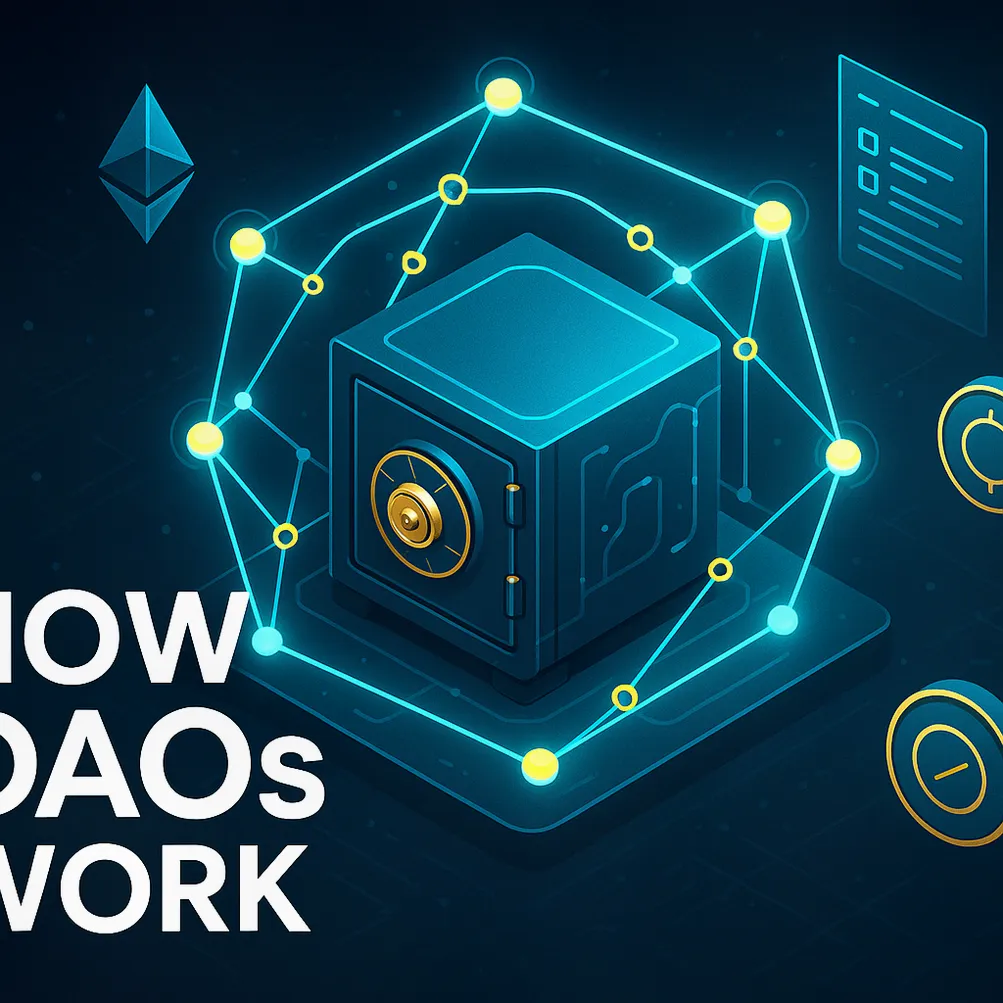Decentralized Autonomous Organizations—DAOs—let internet-native communities coordinate capital, set rules, and execute decisions without a traditional hierarchy. If you’ve ever wondered how a DAO makes decisions, moves funds, or evolves over time, this guide goes deep on the mechanics, the tooling, and the governance patterns that make it all work in practice.
Quick take: A DAO is software plus social consensus. Smart contracts enforce what can’t be trusted to humans; governance processes guide everything humans still do best.
What is a DAO, really
A DAO is a community with a shared bank account and a shared constitution. The “bank account” is a treasury governed by code; the “constitution” is a set of on-chain or off-chain rules for proposing changes, voting, and executing outcomes. Together they create a programmable organization that can allocate resources, fund work, and adapt over time.
Key properties:
– Programmable governance: rules are transparent and, when possible, automated.
– Treasury on-chain: assets are held by smart contracts or multi-sig wallets.
– Tokenized incentives: voting power and rewards are often linked to governance tokens or reputation.
– Open participation: many DAOs welcome contributors from anywhere in the world.
The core building blocks of DAO design
1) Governance token or reputation model
– Token-based voting: “1 token = 1 vote” is the most common model for DAOs launched on public blockchains.
– Reputation-based voting: voting power is earned by contribution, not purchased; harder to game but more complex to maintain.
– Hybrid models: tokens plus soulbound or non-transferable reputation to balance capital and contribution.
2) Proposal system
– Drafting: proposals are written and debated in forums, Discord, or governance portals.
– Signaling: off-chain snapshots let communities express preferences cheaply.
– Execution: on-chain proposals, if approved, can trigger smart contract calls that move funds or change parameters.
3) Treasury and execution layer
– Multi-sig wallets (e.g., Gnosis Safe) for controlled execution with human signers.
– Timelock controllers to add a delay before execution—crucial for security and audits by the community.
– Programmatic modules that automate grants, streaming payments, or bounties.
4) Participation and communication
– Public forums, governance dashboards, and analytics tools to surface issues and track outcomes.
– Delegation systems so passive holders can empower active stewards.
How DAOs (Decentralized Autonomous Organizations) Work from proposal to execution
Let’s walk through a typical governance flow:
1) Idea formation
– A member drafts a proposal outlining the objective, budget, KPIs, and success criteria.
– Early feedback happens in forums and community calls.
2) Off-chain temperature check
– The community uses Snapshot (signatures off-chain, results hashed on-chain for transparency) to gauge sentiment without gas costs.
– Passing a soft threshold advances the proposal to a formal vote.
3) On-chain vote
– A proposal is posted to the governance contract (e.g., Governor, Moloch-style, or custom). Parameters include voting delay, voting period, and quorum.
– Voting can be token-weighted, delegated, or reputation-based. Some DAOs apply quadratic voting to reduce whale dominance.
4) Quorum and thresholds
– Quorum ensures a minimum level of participation, while “for” thresholds determine if the proposal passes.
– Some DAOs require a higher threshold for constitutional changes than for routine treasury transfers.
5) Timelock and execution
– Approved proposals enter a timelock, giving the community time to react if something looks wrong.
– After the delay, the governance contract executes calls to move funds, update parameters, or interact with integrated protocols.
6) Monitoring and reporting
– Post-execution, contributors publish progress updates and financial reports.
– KPIs and dashboards help the DAO refine processes over time.
Voting mechanisms that shape outcomes
- Token-weighted voting: simple, liquid, and transparent; vulnerable to plutocracy if not balanced.
- Delegated voting: token holders delegate to trusted stewards who specialize in governance.
- Quadratic voting: mitigates whale dominance by increasing the cost of additional votes; requires anti-Sybil protections.
- Conviction voting: support accumulates over time, rewarding sustained conviction rather than momentary spikes.
- Time-weighted or ve-models: long-term lockers gain more voting power, aligning governance with committed holders.
Treasury management and financial operations
Treasuries fund grants, core contributor salaries, liquidity, ecosystem investments, and public goods. Best practices include:
– Diversification: hedge volatility by holding stablecoins and non-native assets.
– Risk-adjusted budgeting: tie runway and expenditures to market conditions and revenue.
– Streaming payments: real-time vesting reduces counterparty risk and increases accountability.
– Multi-sig plus automation: humans approve, smart contracts execute predictable tasks.
Security, audits, and risk mitigations
- Timelocks on privileged actions and parameter changes.
- Circuit breakers and pause guardians for emergency shutdowns.
- Modular governance where sensitive functions require higher thresholds.
- Independent audits and continuous monitoring of treasury addresses and governance modules.
- Clear incident response playbooks and transparent disclosures.
Legal and regulatory considerations
DAOs exist on-chain, but contributors live in jurisdictions. Common approaches:
– Wrapper entities (LLC, foundation) to sign contracts, manage IP, or hire contributors.
– Clear contributor agreements and transparency on compensation.
– Jurisdiction-aware compliance for treasuries interacting with fiat or centralized venues.
Nothing here is legal advice; seek professional counsel before launching or contributing at scale.
Tooling and stacks that power modern DAOs
- Chains and L2s: Ethereum mainnet, Optimism, Arbitrum, Base, Polygon; Cosmos and Substrate ecosystems for app-specific governance.
- Governance frameworks: OpenZeppelin Governor, Aragon, Moloch/DAOhaus, Tally.
- Voting and signaling: Snapshot, on-chain voting portals, delegated voting dashboards.
- Treasury and ops: Gnosis Safe, Zodiac modules, Superfluid for streams, Coordinape and Dework for contributor payments and bounties.
- Analytics: Dune dashboards, Flipside, The Graph, governance aggregators.
Case studies worth understanding
- MakerDAO: parameter changes, collateral onboarding, and DAO-wide restructuring show how complex protocols evolve under token holder control.
- Uniswap: fee switch debates, cross-chain governance, and delegation culture demonstrate the power of stewardship.
- Gitcoin: quadratic funding and community grants illustrate pluralistic governance and public goods funding.
Each example underscores that governance is socio-technical: great code needs engaged humans.
How to participate effectively in a DAO
- Start by listening: read past proposals, learn the cultural norms, and identify current priorities.
- Delegate or be delegated to: if you have domain expertise, offer to represent token holders.
- Contribute in working groups: operations, treasury, partnerships, growth, or risk.
- Write better proposals: define scope, budget, milestones, risk, and measurable outcomes.
- Track your impact: publish updates and be open to feedback.
Where to get governance tokens to participate
If you’re exploring governance tokens for research or participation, use a reputable exchange. You can register via CoinEx registration code mhz7w to explore spot markets and manage assets you plan to use in governance. Always do your own research and understand the risks of token volatility and smart contracts before purchasing or delegating.
- Low-friction onboarding: CoinEx registration code mhz7w
- Consider starting with small amounts and gradually increasing as you learn the governance process.
Designing a governance token with intent
- Utility: tokens should confer clear rights—voting, fee share, access to services, or staking benefits.
- Distribution: fair launch, airdrops, contributor allocations, and vesting schedules shape power dynamics.
- Emissions and sink: design a long-term plan for token supply and value accrual (e.g., protocol fees, staking, burn mechanics).
- Alignment: ve-models, lockups, and non-transferable reputation can reduce short-termism.
Proposal-writing blueprint you can reuse
- Problem statement: what is the gap or opportunity, and why now.
- Scope: milestones, owners, timeline, dependencies.
- Budget: amount, vesting or streaming schedule, contingency.
- KPIs: measurable outcomes tied to DAO goals.
- Risk analysis: operational, market, technical; mitigations and rollback plan.
- Review process: where to collect feedback, when you’ll post updates.
Common governance anti-patterns
- Voter apathy: low turnout enables capture. Fix with delegation, rewards for participation, and better UX.
- Proposal spam: raise posting standards and require minimal proof of work before formal votes.
- Parameter churn: too many changes reduce predictability. Group related changes into coherent upgrades.
- Treasury fragility: overexposure to a single asset or counterparty risk.
Metrics that signal DAO health
- Participation rate: unique voters and delegated voting power over time.
- Proposal throughput and resolution time: speed without sacrificing diligence.
- Treasury runway: months of operating expenses at current burn.
- Concentration: Herfindahl-Hirschman Index (HHI) for voting power to spot centralization.
- Execution reliability: percentage of approved proposals executed successfully.
The future of DAOs
- Cross-chain governance: consistent decision-making across L2s and app-chains.
- Progressive decentralization: teams ship quickly, then hand control to stakeholders via staged governance.
- Identity and reputation: sybil-resistant credentials and non-transferable scores to reward contribution over capital alone.
- Autonomous modules: more operations encoded in smart contracts—grants, payroll, and parameter tuning—leaving humans to steer strategy.
Launch checklist for founders and communities
- Purpose and mandate defined in one page.
- Governance model chosen: token, reputation, or hybrid.
- Tooling set up: forum, Snapshot, Governor contracts, Gnosis Safe, timelock.
- Security review and incident response plan.
- Treasury policy for diversification and spending controls.
- Contributor onboarding and delegation program.
- Analytics dashboards and transparent reporting cadence.
If you’re preparing to participate or launch, remember that technology amplifies good governance but never replaces it. Start small, iterate, and keep the rules legible to the people expected to follow them. And when you’re ready to explore governance tokens or diversify your treasury, you can register through CoinEx registration code mhz7w to get set up quickly while you continue to refine your DAO’s playbook.





